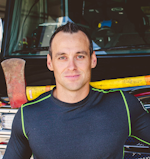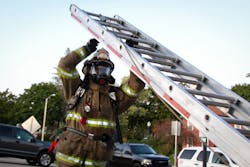Physical ability is an absolute for a firefighter. Either a person is healthy and strong enough to do the job or not. This might sound blunt, but it is how it must be. The safety of customers and of the entire crew, let alone the individual firefighter, is at risk without this.
What can be done to ensure that a firefighter, or tactical athlete, is at peak physical ability when the alarm sounds? Cleaner eating (the consumption of more whole foods that are in their natural state and of less processed foods, such as refined sugar) can be important to sustaining the tactical athlete. So, too, can the implementation of health and safety precautions throughout the department.
However, having a system in place that assesses across-the-board, job-related skills and movements is essential to making certain that the training program properly prepares individuals and that, once on the line, firefighters do their job safely. That said, creating a standard for this assessment can be very difficult. We work in such a dynamic environment, and it requires physical ability on many different levels.
Look at the type of runs that your department makes on a consistent basis. The purpose: Identify the low-volume, high-risk calls that have a significant chance of injury or that offer substantial challenges to the firefighter for completing a physical task. At the same time, ask yourself this: Can you validate asking a relative newcomer to do something that a veteran can’t do? It might be useful to consider CPAT (candidate physical ability testing) and/or academy entry or exit standards.
Implementing and following through with NFPA standards will ensure that you hit your target accurately. (Applicable standards include: NFPA 1500—Standard on Fire Department Occupational Safety, Health, and Wellness Program; NFPA 1001—Standard for Fire Fighter Professional Qualifications (5.3.9/5.3.10); and NFPA 1583—Standard on Health-Related Programs.)
So, what does the assessment need to include? What movements should it include? Here is a basic a course that can be followed to start an annual program within your department:
- Ground Ladder Raise and Climb—Raise and extend a 24-foot ground ladder against a building, and safely climb the ladder to touch the roof’s edge.
- Confined Space Prop—Enter the confined space prop and crawl through it safely while maintaining awareness of your equipment, such as SCBA or any other equipment that you would take on a normal run.
- Hose Drag—Drag 100 feet of charged 1½-inch hose to a mark on pavement, drop to one knee, open the nozzle and knock down traffic cones with the water stream.
- Dummy Drag—Drag a rescue dummy 100 feet with appropriate technique.
- Ventilation Simulator—Move the sled portion of a ventilation simulator approximately 3 feet by striking it with a shot mallet.
- Hose Pack Carry—Pick up and carry one hose pack up five flights of stairs and then down. Assistance may be requested for placing the hose pack over the SCBA tank.
To increase one’s strength for the ladder raise and climb, one can do: three sets of 10 clean-and-press exercises; three sets of 10 seated military dumbbell presses; and/or three sets of front squats.
Strength for the confined space prop can be increased via reverse crunches, leg raises and/or cross-body reaches. Reps should be three sets of 30 seconds on, 30 seconds off.
Hose-drag performance can be increased via a routine of three sets of 10 seated rows, lat pulldowns and/or reverse flys.
Three sets of 15 deadlifts and/or hamstring curls will help build strength for the dummy drag, as will three sets of sled pulls (30 seconds on, 30 seconds off).
Two exercises using a medicine ball help improve ventilation simulator strength: three sets of medicine-ball slams and/or medicine-ball wall throws (30 seconds on, 30 seconds off). You also can do three sets (60 seconds on, 60 seconds off) of battle ropes.
Preparation for the hose pack carry can include five sets on a stair-climbing machine with a sandbag or weighted vest (60 seconds on, 60 seconds off).
Staying in the game
Timing for the completion of the course starts on first movement at the first station (ladder raise) and stops once you reach the basement hallway from the hose pack carry. The test will be at the fire station and set up with at least 50 feet of “cool down” walk between each station.
If a firefighter doesn’t complete the test in the allocated time, he/she may retake the test within a week. (Allocated time depends on how far the course is spaced and average times that are associated with such parameters.) If he/she fails the retake, the test can be reattempted in approximately 3 months. Whenever a firefighter fails the test and desires to retake it, the individual should be encouraged to practice the tasks and be given resources for a physical fitness program. If a problem with technique was the issue, the firefighter needs to concentrate on specific movements. If a problem is one of strength, endurance or cardiovascular issues, a physical improvement plan needs to be written. Regarding these latter matters, the plan must be considered on a case-by-case basis. Overall, the work to improve should be done while on shift (or while at the station for part-timers or volunteers). The firefighter shouldn’t be expected to carry out the work on an individual’s own time.
So, what of those who aren’t able to complete the assessment in the allocated time? Should a written warning be issued? Should the individual be terminated? Should nothing be done? Ultimately, leadership is responsible for designing a training program that guarantees that everyone is able to perform these tasks. And what do firefighters do better than any other profession out there? Training! Lead from the front, and train with them until they can do it with their eyes shut. It’s no different than if a firefighter couldn’t drag an attack line into a structure, load a hose pack or hit a hydrant. Training on these movements will contribute directly to firefighters’ efficiency and safety on the fireground. Firefighters must be helped to acquire and maintain the skills that support them in doing the job that they love, and it can’t be forgotten that all the young eyes are watching closely to learn how to be true firefighters.Those who I look up to the most in this industry have taught me that the longer that you are on the job, the more effect it has on one’s body. Time on the job is just that: time on the job. However, years of service is not rationale for ambivalence; in fact, it’s the exact opposite, giving you definitive measures for where you are on specific tasks and what you need to do to stay in the game longer. Look at any performance athletes: The longer that they are on the field, shall we say, the more rehab, training, assessments, treatments, dry runs and check-ups they must go through (required, by the way) to stay where they need to be to perform. No doubt, this costs money, time and energy and causes some complaints. So why would teams invest large amounts of money and time to keep their most veteran players in the game? Because the teams understand the importance of having such a great resource in the game; veteran players teach, they see things that other players miss; they’re able to adapt based on previous situations that they encountered and by using their experience to lead the team to victory.
Tactical athletes are no different, and those veterans who lead from the front create a culture that’s unmatched in emergency services; a team is strongest with its strongest leaders up front.
So, leaders should get involved. Their opinions should be requested. Their likes and dislikes should be considered. In this way, buy-in is maximized, and a reaction that things are being shoved down their throats is minimized/avoided.
Being able to do the job and being accountable to what’s at stake should be a foundation of any and all emergency services. What will get us all operating at a higher level is support from each other; pushing each other and ourselves to always get better, to always be a student of the job, and to keep fighting not only for yourself but for the person who is next to you.

Brandon Green
Brandon Green is a captain with the Baraboo, WI, Fire Department and lead trainer for the department’s tactical fitness program. He is an instructor for the Madison College fire academy and a coach with the BEDYNAMIC training program. He is a graduate of the World Instructors Training School, which is recognized by NCCA, ACE and IACET, and has been coaching and training for 15 years. Green founded his own fitness system and fitness facility, and he trains all walks of life, from people who have neuromuscular diseases to professional athletes, but he specializes in tactical fitness. You can contact Green at [email protected].








